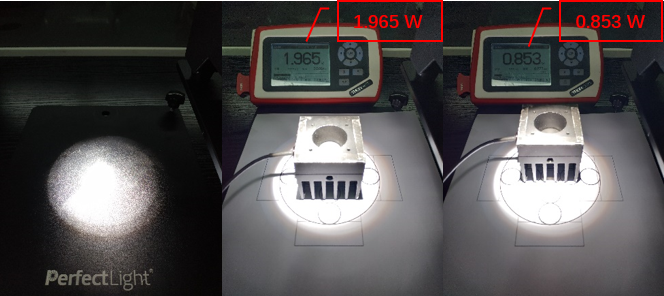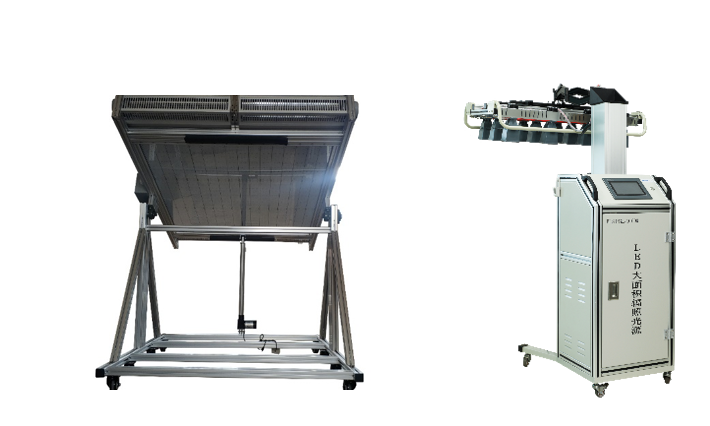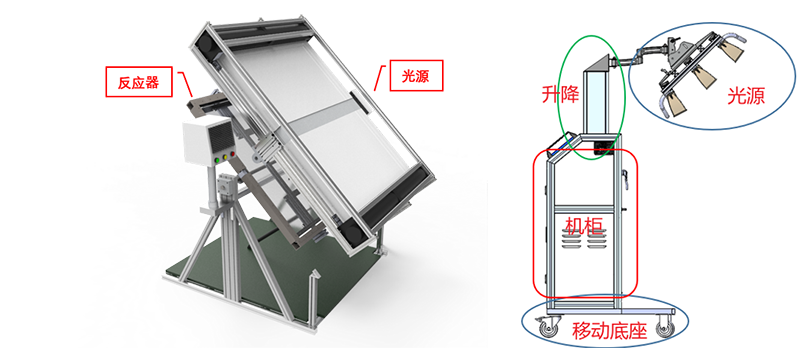In the article "Analyzing Light Sources for Photocatalytic Experiments: Solving the Light Source Puzzle," it is mentioned that when selecting a light source, factors such as light intensity, light source stability, and spot uniformity need to be considered. Xenon lamp light source is the closest light source device to the solar spectrum. However, in photochemical experiments, xenon lamp light sources cannot meet the requirements for large-area irradiation. With the gradual development of the concept of "Hydrogen Farm"[1] and the improvement in the efficiency of photocatalysts for hydrogen production from water splitting[2], photocatalytic hydrogen production equipment is gradually transitioning from laboratory experiments to small-scale production.
During the laboratory phase, the light area of photocatalytic hydrogen production reactors is only 40 cm2 in size, and the spot size of xenon lamp light sources can meet this requirement. However, in the small-scale production phase, the size of photocatalytic hydrogen production reactors is no longer limited to 40 cm2; square meters of reactors are needed for large-scale production. At this point, the spot size of xenon lamp light sources cannot meet the production requirements.
Firstly, xenon lamp light sources directly produce non-uniform light spots. The light spot characteristics are stronger in the central area and gradually decrease in light intensity as you move outward from the center, as shown in Figure 1.

Figure 1: Comparison of Xenon Lamp Light Spot Image and Measured Light Power at Center and Edge Positions
Secondly, xenon lamp light sources are thermal light sources and generate high heat during operation. This not only directly affects the lifespan of xenon lamp bulbs but also has a thermal impact on the materials being irradiated. To address the heat issue, xenon lamp light sources typically require multiple heat dissipation components and light-filtering structures. Therefore, large-area xenon lamp light sources usually have a relatively large volume. When there is a need for large-area irradiation, such as using multiple xenon lamp light sources simultaneously, it places significant demands on the experimental space and power supply.
Due to constraints related to spot characteristics and equipment volume, xenon lamp light sources cannot be applied to experiments requiring large-area irradiation. To address the issue of large-area light sources, Perfectlight Technology uses LEDs as the light source carrier and has developed two different large-area irradiation light sources for different experimental scenarios: the PLS-DPCR-1.0 square meter-scale photocatalytic reaction demonstration device and the PLS PGL-O1000 LED Large-Area Irradiation Light Source.

Figure 2: PLS-DPCR-1.0 Square Meter-Scale Photocatalytic Reaction Demonstration Device and PLS PGL-O1000 LED Large-Area Irradiation Light Source
When xenon lamp light sources cannot be applied to experiments requiring large-area irradiation, the choice to use LEDs as the light source carrier is primarily because LED light sources are cold light sources with minimal heat output and small heat dissipation components. Furthermore, LED light sources have a single light-emitting body in their structure, which can be integrated into different structures based on the usage scenario, such as surface array light-emitting bodies, flexible light strips, rigid light bars, and more. Additionally, LED light sources can not only output narrow-band wavelengths but also achieve special wavelength requirements, such as simulating the solar spectrum, through the fitting of multiple light-emitting bodies.
Against the backdrop of the "dual carbon" initiative, hydrogen energy, as a zero-carbon renewable clean energy source, has received significant attention. Photocatalytic hydrogen production from water splitting is one of the important methods for hydrogen gas production.
The PLS-DPCR-1.0 square meter-scale photocatalytic reaction demonstration device is mainly designed for use in large-area irradiation experiments at close distances of 5~10 cm. It has a radiation area of 1×1 m2 and provides an irradiance of 300 mW/cm2 within the working distance, simulating the solar spectrum with 90% uniformity. It is paired with a 1×1 m2 flat reactor for photocatalytic hydrogen production experiments. The flat reactor has a gas collection structure and measures gas production rates using a mass flowmeter.

Figure 3: Schematic Diagram of PLS-DPCR-1.0 Square Meter-Scale Photocatalytic Reaction Demonstration Device and PLS PGL-O1000 LED Large-Area Irradiation Light Source
Photocatalytic degradation includes research areas such as photocatalytic degradation of organic pollutants, photocatalytic degradation of VOCs, photocatalytic wastewater treatment, and photocatalytic sterilization. In the current context of ongoing pandemic precautions worldwide, the method of using photocatalysis for sterilization has gained attention. Photocatalysts generate active radicals after exposure to light, and these active radicals can kill bacteria or viruses, achieving the goal of large-area sterilization and disinfection.
The PLS PGL-O1000 LED Large-Area Irradiation Light Source is primarily used for large-area space irradiation and can be applied to research in large-area photocatalytic sterilization. It can be used in applications such as laboratory benches, analytical laboratory surfaces, corridors, hospital wards, and other scenarios requiring large-area light-based disinfection and sterilization. In its standard working state, the light source angle can be adjusted to meet different angle illumination needs, including horizontal, inclined, and vertical. The average irradiance is ≥9 mW/cm², with a uniformity of ≥80%. It comes with bottom-mounted casters for easy mobility and storage. The LED light source can also be equipped with different wavelength light-emitting units to meet various wavelength illumination application scenarios.
The spectral and optical power of both xenon lamp light sources and LED light sources can be customized as needed. If you have any requirements for experimental light sources, please feel free to inquire on the website.
[1] Zhao Yue, Li Rengui*, Li Can*, et. al. A hydrogen farm strategy for scalable solar hydrogen production with particulate photocatalysts[J]. Angew, 2020, 132(24), 9740.
[2] Zhao Daming, Guo Liejin, Shen Shaohua*, et. al. Boron-doped nitrogen-deficient carbon nitride-based Z-scheme heterostructures for photocatalytic overall water splitting[J]. Nature Energy, 2021, 6, 388.